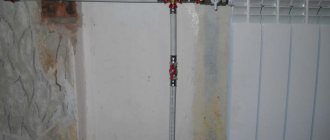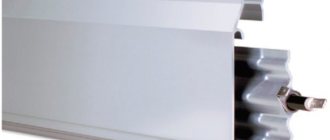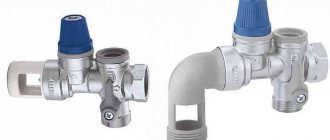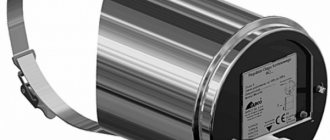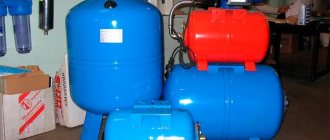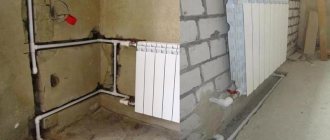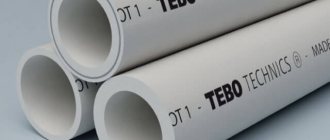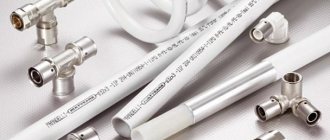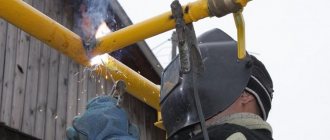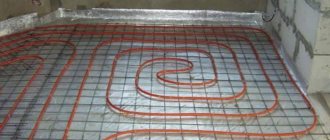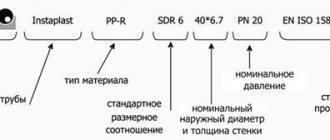Decorative design of the heating pipeline
If it is not possible to hide the heating pipeline, then choose one of the ways to decorate it:
- finishing with prefabricated universal covers-boxes;
- decoration.
Universal cases-boxes
Prefabricated universal covers for pipes are made of metal, plastic or valuable wood and are a structure mounted on the wall using special brackets and, depending on the design, accommodating one or more parallel pipes.
The material used to make such pipeline casings must have a sufficient degree of heat resistance so as not to deform or lose aesthetics under the influence of heat from the heating circuit. To more evenly distribute heat flows throughout the room, the decorative lining on the pipes may have perforations or slots that ensure heat exchange between the pipeline and the room air, but this design of the elements makes it difficult to clean them from dust.
The decorative overlay on the heating pipe also performs a protective function - it eliminates the possibility of getting a burn from direct contact of the body with the circuit.
When choosing a universal casing in a store, you should give preference to types whose installation is not accompanied by damage to the existing finish of the room, and disassembly, if necessary, will not take much time.
You can also hide heating pipes with boxes of your own making. A frame is mounted from a CD profile, which is covered with plasterboard or plastic.
Decoration of heating pipes
Those who want to go beyond the template and fit the heating system into the interior of the room are looking for non-standard ways to design the pipeline, of which there are as many as there are room design options. You need to start by analyzing the existing finish and color scheme so that the design of the outline fits into the tone of the cladding or, on the contrary, contrasts effectively with it. Let's give a few specific examples.
The vertical riser of the heating circuit can be finished to look like a bamboo trunk. To do this, select a piece of bamboo wood of the required diameter, which is split longitudinally on two opposite sides. Then the transverse partitions are removed from the inside of the halves to obtain two longitudinal halves of the shell pipe. PVA glue is applied to the splitting surface, the halves are applied to the riser and aligned in their original position, after which they are pulled together with nylon clamps until the glue dries. After the clamps are removed every other day, the yellow dry bamboo can be painted green.
A vertical pipe can also be decorated to resemble the trunk of a birch or other tree, if you cover it with bark or paint it artistically - the temperature of the coolant is not so high as to threaten these finishing materials with ignition.
Horizontal sections of the heating system, as a rule, have a smaller diameter than vertical risers, and for their design you can use sesal or manila twine, which is wound onto the pipe in tight coils with inserts of decorative elements - flowers, leaves, etc.
Which way is better
The choice of method is determined by the material of the heating system pipes. If it is a copper alloy, stainless steel, i.e. durable materials that serve regularly throughout the entire life of the building, they can be walled into the wall under a layer of plaster.
A good option for masking pipes made of any materials is to install screens. They are simply irreplaceable in rooms where metal risers extend a long distance from the plane of the walls.
The advantage of this method of decorating heating pipes will also be a wide color palette and a variety of screen shapes, from which you can choose a copy that is in harmony with the style of any interior.
It is easy to install and does not interfere with heat transfer, which is very important both for private houses and apartments with centralized heating. https://www.youtube.com/embed/1ixU3Fp6-74
How to hide heating system pipes
This question worries many developers who are just thinking about or are already installing a radiator heating system for a country house. To a greater extent, difficulties with laying pipes arise during the reconstruction of old buildings and industrial premises.
Sergey Bulkin Head of the technical department of the “Internal engineering systems” direction at REHAU
In modern construction practice, heating system pipes are most often hidden in a screed or under plaster. But there are old buildings where additional load on the floors is unacceptable. Accordingly, it is impossible to make a screed. In addition, in wooden houses and in some categories of historical buildings, where the so-called. “wet work”, there are also no screeds and plasters. In these categories of buildings, plinth routing of the lines of the radiator heating system will allow you to hide the pipes and at the same time ensure the aesthetics of the solution.
Skirting channels can be industrially manufactured - metal, laminated fiberboard or chipboard, plastic, or made directly on the installation site. In this case, along the route along which the heating pipes will pass, a frame is mounted, for example, based on metal profiles, which is then sheathed with plasterboard or wood.
The choice and method of installing a plinth channel is based on the preferences of the developer, the design of the room and the temperature parameters of the heating system.
Important: the pipes through which the coolant circulates are subject to thermal expansion .
In addition, the materials of the pipes, fittings and plinth channels used are subject to certain requirements for strength, fire safety, tightness of connections, durability, manufacturability of installation, environmental friendliness and aesthetics.
Therefore, when installing baseboard wiring, proven and certified solutions should be used.
Ways to hide heating system pipes
Any pipeline, even the most modern design, does not decorate the room, since there are no pipes whose production design would be universal for any interior. One way to remove the visual presence of a heating system in the interior of a room is to hide the pipeline, which is done in several ways.
Installation of the pipeline in wall grooves under the molding
When making major home repairs, linear markings of the future heating circuit are made along the walls. Then, parallel cuts are made in the plaster layer of the partitions and load-bearing walls using a grinder and a concrete disc at a distance of 3-5 cm from each other.
In partitions, the depth of the cut can be increased, but taking into account the thickness of the wall, since, without experiencing external loads, it is still a self-supporting structure, the weight of which is significant.
The plaster layer between the cuts is removed with a hammer drill with a chisel attachment. Brackets are attached to the resulting groove-groove and the pipeline is installed, which, depending on the depth of the resulting channel, turns out to be completely or partially recessed into the wall, but not walled up in it.
This position of the contour makes it possible to neutralize linear deformations of the pipeline, as well as displacement of building structures in the event of uneven settlement of the building.
On top of the channel with the pipeline, decorative plastic or metal moldings of a suitable size, color and profile (flat or convex) are attached to the wall with self-tapping screws.
This method allows you to hide steel or PVC wiring of a heating system with a diameter of up to an inch, while maintaining the possibility of its inspection and maintenance after simple dismantling of decorative trims.
Hiding wiring with a false wall
If the room is spacious enough, and reducing its length or width by 5-10 cm is not important, then the wall on which the existing heating distribution is located can be completely hidden behind a light partition - a false wall made, for example, of plasterboard.
Work begins with marking the frame, which can be made of wooden blocks, a rectangular steel profile or a special CD profile for GC sheets. The frame design must include inspection hatches for access to shut-off valves and the ability to monitor the condition of the circuit.
To increase the functionality of the gypsum board partition, the wall can be covered with foil penofol before installing the frame, which will be an additional means of thermal insulation of the room.
Sheets of plasterboard are laid on the mounted frame and secured with self-tapping screws, on top of which one of the types of decorative finishing is performed.
Sealing pipes in the floor
Laying pipes in the floor using technology is not much different from embedding a pipeline in a wall. But there are some nuances here. Depending on its location, the system can play the role of a warm floor or, at least, a warm baseboard. This type of heating has great advantages: it heats the walls evenly. Thus, you can insulate the coldest wall on which the window is located.
It is important to remember that the concrete screed must be thick enough so as not to break if the place where the route runs is accidentally stepped on.
Installation of pipes in the floor is carried out when laying the heating system.
The step-by-step list of works is as follows:
- A groove is made in the floor, the depth of which is calculated taking into account the thermal insulation material and mortar. It is important that the top edge of the pipe does not exceed the floor level.
- The pipeline in the casing is laid in a groove.
- The system is being tested.
- The groove is sealed with concrete.
- The flooring material is laid on top.
In this system, if it is produced in a private house, it is worth providing a circulation pump, because in horizontal pipes the flow of water slows down. It is also worth remembering that if there is a breakthrough, you will have to break the floor. And of course, you need to have an executive diagram of the work in order to know the location of the line in the floor.
How to close heating pipes in a private house
When choosing which method of masking heating pipes in a private house to resort to, it is worth taking into account the design features of the building. If the floor in the house is concrete, then the pipes can be connected to the heating system. But this option requires a mandatory screed; it is also necessary to insulate the base and lay a layer of expanded polystyrene.
If floor heating does not play a significant role for you, then you can make grooves in the floor and place pipes with thermal insulation in them. This way you will be provided with an efficient heating system.
Location of pipes in walls
This masking method is well suited if you are installing a new heating system. You will need to do the following:
At the very first stage, you need to draw up a pipe laying diagram. To do this, you need to know the diameter of the pipes (this must be taken into account), thermal insulation and the thickness of the wall layer that will be sealed. Then a recess (groove) is made in the wall, running along the entire length of the pipe placed in the wall. The grooves are made using a wall chaser or a hammer drill. Also, special attention should be paid to those areas where bends and tees will be located
It is important to place them in such a way that access to them is free. Thermal insulation is put on the pipe itself and it is placed in the groove. In order to install pipes in the wall, you need to use brackets
For them, you need to drill holes in the wall, and place dowels in them, which are designed to fix the pipes. At the final stage, the pipes need to be tested and sealed with mortar.
Location of pipes in the floor
Thermally insulated heating pipes in a concrete floor groove
- in the case of the floor, as with the walls, the first priority is to draw up a pipe laying diagram, taking into account their thermal insulation and diameter;
- a groove is made in the floor into which pipes are placed;
The top of the pipe should be below floor level.
Next, you need to put thermal insulation on the pipe and lay it in the cutouts of the concrete floor; Be sure to test the pipes for possible leaks.
The screed on top of the pipes should be thick enough. This is necessary to ensure that it does not accidentally break and the pipe does not become deformed.
This method of pipe arrangement has one drawback. It lies in the fact that if there is a leak, the gate will have to be broken and repaired.
Types of skirting boards for heating systems
Skirting boards for heating systems are made of heat-resistant plastic, metal, and laminated chipboards. The main condition for a protective casing is the presence of longitudinal holes at the bottom and top of the structure.
The materials used in the manufacture of skirting boards must not be afraid of moisture, be resistant to abrasion, mechanical and chemical influences. This will maintain aesthetics during long-term use. The environmental characteristics of the products are important - the material should not emit harmful chemicals when heated.
The following types of skirting boards are popular:
- Perforated enameled metal structures. They maximize heat transfer, are visually light, and do not burden the interior. Such designs can be made independently or purchased ready-made. Metal structures are easy to install, they can be cut and joined in any variation.
- Skirting boards imitating expensive wood species. They are made from plastic or laminated boards. Hobbyists can order products made from natural wood, but in addition to expensive materials, they will have to pay for mandatory protective treatment. The wood is treated against fungus and etched with fire-resistant compounds.
- Aluminum skirting boards for painting. They are loved by those owners who want to make the heating system invisible and merge it with the walls. Aluminum structures are distinguished by lightness, strength, practicality, and affordable price.
We recommend that you familiarize yourself with: Pipe routing diagrams and options for installing a heating system in a private house with your own hands
Baseboard heating systems
Depending on the coolant, baseboard heating systems are divided into:
- Liquid. The system consists of copper pipes where hot water or antifreeze moves.
- Electrical. Electrical energy transformed through wire and air heating elements is used as a heat source.
- Infrared. They emit thermal energy from special tapes attached to the base of the walls.
Water system
A baseboard heating system, where water or glycol flows through copper tubes, is called water or liquid. Flat parts made of copper or aluminum are mounted on the pipes.
The coolant in the tubes heats up to 85 °C. The optimal heating temperature is considered to be 65 °C. The degree of heating is adjusted automatically or manually. The efficiency of the circuit decreases when the length reaches 12.5 m.
The water version of the baseboard with heating pipes can be powered by solid fuel, electric and gas boilers, solar collectors, and heat pumps.
Electric cable
The basis of the electric baseboard is an electric heating cable. It can heat up to 100...120 °C. This is significantly higher than in a conventional heating system. The decorative casing heats up to 50...60 °C.
The design is installed in modules 1 and 2 m long. They can be connected into one circuit, the entire system operates from a regular 220 V outlet. Power consumption is quite small: on average 0.150 kW per linear meter.
The operation of the heating baseboard is controlled automatically; the set temperature is maintained by a built-in thermostat. According to calculations, 5 meters of electric heating is enough to heat a room of 20 square meters.
Infrared heating
The heat source in infrared baseboard heating is an infrared tape. It is fixed above the floor and closed with a decorative box made of plastic or plasterboard.
By analogy with the electrical cable system, the structure is equipped with heat sensors and a measuring apparatus with an information display is installed.
Installing the system is very simple, its operation is absolutely safe for humans.
Operating principle of baseboard heating
Heating using warm baseboards guarantees uniform heating of the entire room.
The baseboard heating system is based on a special way of installing its constituent elements - at the lower border of the wall. Thus, the ability to distribute heat flows more rationally is achieved. Being installed along the entire perimeter of the room, baseboard heating convectors transfer heat not so much to the surrounding air, but directly to the walls, from which, in turn, the room air is heated. It is recommended that baseboard heating radiators be located primarily along external walls, but it is also possible to install them along interior partitions.
Heating devices are so compact that in appearance they are almost indistinguishable from ordinary baseboards. Inside each convector there are heat exchange modules, which, depending on the type of system, can be liquid or electric. The thermal conductivity of these heating devices is close to the maximum possible, since their structural elements are mostly made of copper and aluminum. It is enough to heat baseboard heating radiators only to a temperature of 40–45 °C.
Installation of a baseboard heating system can be done in the form of a podium on which furniture is installed
The housings of the devices are equipped with two rows of slots: cold air flows in through the lower ones, and heated air comes out through the upper ones. Baseboard convectors for electric and liquid heating systems are installed close to the wall, and the heat flows from bottom to top along the surface of the wall. As a result, judging by the reviews, baseboard heating provides more uniform heating of the room compared to conventional radiators.
Two different concepts should not be confused: baseboard heating pipes and baseboard water heating. The first of them means one of the methods of supplying coolant (from below) to a conventional radiator, and the second means a special type of heating system.
First, let us pay attention to the features of baseboard pipe routing in traditional water heating systems.
What is
Baseboard ducts for heating pipes are installed around the perimeter of the room. The structures contain heating elements, from which warm air rushes up the walls and spreads throughout the room. Heating skirting boards are designed to completely replace conventional heating radiators, providing the opportunity to free up additional living space.
The contents of the channels (pipes, radiators) are covered with a decorative platband of a special design with longitudinal holes at the bottom and top. In this case, the decor can be made of plastic or metal parts.
The dimensions of skirting boards for heating pipes do not exceed 13.5 cm in height and 3.6 cm in depth (width).
"HZ skirting systems"
Modern construction technologies make it possible to cast interfloor floors that do not require the installation of leveling ties, in which it was possible to lay a lot of communications. Where to place pipelines, bundles of cables and wires? Heating appliances, power and low-current sockets are located in the lower part of the premises. In the false ceiling of the previous floor?
The most suitable way is to lay communications in special baseboard and vertical channels HZ (Hans Weitzel GmbH), which are a precisely coordinated system consisting of fasteners, a decorative profile, connection points for heating devices and connection points for power and low-current lines.
“Expensive,” someone will say. But how much does a screed cost? To install 1000 m2 of screed, the cost of concrete alone will be at least 320,000 rubles. The cost of materials for installing plinth wiring will not exceed 25,000 rubles. An impressive difference, especially considering that concrete work is also many times more expensive. In addition, when using channel laying, access to communications is maintained without damaging the interior.
The advantages of external installation of heating pipes are obvious: no need to hollow out channels in the masonry walls, no construction waste in residential premises, no need for additional repair work, short installation, cost savings.
Plinth distribution systems that correspond to the current state of technology include hiding the pipes of heating systems.
The HZ company produces plinth wiring systems for hiding heating pipes:
Skirting profiles
Pipes laid parallel to the floor are lined with HZ skirting profiles. A variety of decors and different sizes of skirting boards will satisfy any desire. HZ mounts provide quick and easy installation.
There are HZ plinth profiles designed both for laying pipelines and electrical cables, and for laying pipelines only. The fastenings and decorative profile are made of durable, heat-resistant, environmentally friendly plastics, characterized by increased dynamic strength.
HZ system fasteners contain devices for adjusting the position of the decorating profile according to level. To level out minor unevenness in walls and floors, the decorating profile is equipped with an elastic edge that can accurately replicate the shape of the mating surface.
The HZ plinth system allows you to easily and quickly lay copper pipelines up to 22 mm and metal-plastic pipelines up to 20 mm.
Radiator connection systems
With HZ systems, a quick and aesthetic radiator connection is achieved. All types of connections are offered: soldering, pressing, screwing. Their use when laying pipes externally means a clear saving of time.
Profiles for risers
For vertical installation of heating and water supply pipes, HZ offers riser profiles in L and U shapes in seven different sizes. Pipes on the walls and ceiling are hidden without difficulty.
HZ product catalog in PDF format
Laying communications in channels allows you to clearly delineate the stages of general construction and installation work in buildings, reduce the time and cost of installing communications, improve the work culture, and provide easy access to communications during operation.
For questions regarding the supply of skirting boards for heating pipes, please contact: (495) 995-01-08;;; 8-916-116-85-25
Advantages and disadvantages of baseboard heating
Before you refuse to buy skirting boards for heating pipes, you should know about the following advantages:
- thermal energy is evenly distributed throughout the room, and the peculiarity of infrared radiation is such that only translucent objects are heated;
- uniform heating of air masses is observed, which is difficult to achieve in the case of convection;
- the human body perceives infrared radiation as natural;
- the ceilings have a temperature approximately equal to body temperature, and therefore there is no imbalance during interaction;
- the walls and ceiling are dry, and therefore there is no condensation effect;
- installation of such a system is very simple, and the plinth for hiding heating pipes is very suitable: various elements are not visible during visual inspection and in the photo, which is very aesthetic;
- It is also very easy to carry out repairs on baseboards under the heating system;
- when using baseboards, the system allows the use of special thermostats that maintain a certain microclimate in the room;
- the average temperature of the coolant does not have a negative effect on the efficiency of the system, but on the contrary, it allows you to save up to 30-40% of the energy spent on heating it.
Of course, such a system has disadvantages:
- the heating circuit under the baseboard cannot be longer than 15 meters in order to maintain the efficiency of the system. In large buildings, it is necessary to use distribution manifolds that allow you to combine several circuits within a building or room;
- cracks in the baseboards should not be allowed to be blocked so that heat flows are distributed evenly, and infrared radiation warms up the entire room without obstacles. Naturally, it will not be possible to completely abandon the furnishings of the room, therefore it is necessary to designate enough space on each of the walls, evenly distributing such areas;
- On the floor plinth for heating pipes, it is unacceptable to install various decorative overlays that worsen heat transfer performance;
- since the radiators of the heating system will be adjacent to the wall ceilings as tightly as possible, the use of materials in the walls that are not resistant to the formation of cracks, other deformations and subsequent destruction is unacceptable;
- the cost of such a system is quite high, because The design uses expensive materials, the refusal of which will affect the efficiency of operation.
Components for installing baseboard wiring
When installing a heating system with the connection of radiators from baseboard ducts, it is important to remember that the reliability of its operation depends on the quality of the system components. We draw your attention to the range of components - internal and external corners of channels, connecting plates, fittings, etc., as well as their technical characteristics.
Sergei Bulkin
Before installing the baseboard heating system, make sure that the pipes, fittings and baseboard channels are compatible with each other. Otherwise, due to thermal elongation of pipes and an improper system of their fastening, deformation of pipes, fittings and the baseboard channel itself is possible.
You should also pay attention to the resistance of the plinth channel material to high temperatures, because the pipes in the plinth channels are not thermally insulated. For example, the maximum permissible coolant temperature in baseboard wiring with channels made of flame-resistant and self-extinguishing PVC should not exceed 70 °C.
The most important component of a heating system is the heating pipes. For baseboard wiring, you should choose pipelines that are durable and reliable. For example, such as PE-Xа/Al/PE metal-polymer pipes, with an inner layer of cross-linked polyethylene (PE-Xа). Such pipes retain their shape under the influence of temperature of the coolant circulating through them and have a minimum thermal elongation value.
The coefficient of thermal expansion of such pipes is 0.026 mm/mK with a pipe diameter of 16 or 20 mm.
The next component of the baseboard wiring system is a set of fittings and components necessary for connecting pipes to heating devices.
Sergei Bulkin
Heating devices can be connected through shut-off and control valves using plinth crosses with L-shaped connecting pipes. Or through the lower threaded holes using corner telescopic threaded clamp connections through skirting crosses with straight connecting tubes or through T-shaped elements.
The range of components and their technical characteristics affect the speed, manufacturability and reliability of connections.
For example, if the sliding sleeve connection technique is used when installing pipes and radiators, then the reliability of the system increases, because there are no seals that wear out over time. Thus, the weak link is eliminated from the system. The sealing function is performed by the pipe material, which increases the service life of the system, which exceeds 50 years.
We also pay attention to the decorative properties of the plinth wiring. Because The baseboard channel is always visible, we select the color of the channel material that will fit into the design and interior of the room.
Features of baseboard heating
From its invention to the present day, heating has been divided into two types - convection and panel radiant. In the first case, the air is first heated from the hot surface of the heating device (radiator battery, convector), after which it circulates in the room and gradually heats it up.
In the second case, objects in the room are initially heated, and the air is heated from them by useful infrared radiation, which does not dry out the air or remove oxygen from it, and this process is secondary.
Among the old examples are stoves in village houses, tiled stoves in ancient mansions, in a modern interpretation - heated floors, but what about baseboard heating and what type of heating does it belong to?
Heating a room using a warm baseboard allows you to ensure a uniform supply of heat throughout the height and area of the room being treated
Let us turn again to the opinion of the manufacturers. They unanimously claim that the heat radiated along the perimeter rises from the floor to the ceiling along the walls, warms them evenly and creates a kind of curtain from the cold penetrating from the outside. Once warmed up enough, they themselves begin to give off heat.
In fact, the temperature of walls at different heights fluctuates in the range of 26-30 ºС, and in order for heat to transfer from them, the surface must be heated much more strongly. Therefore, talk about the coveted infrared heat emanating from the walls is not so much the truth as a marketing ploy.
The planes of thermoplinths emit maximum heat at the level of the feet. It’s not just pleasant, but also optimal for well-being and health (+)
It is more correct to say that thermal baseboards are also convectors with a high surface temperature. It’s just that the room is heated more evenly by warm air currents, both emanating directly into the room and ascending along the walls. Heated walls are a guarantee that you will not find dampness or mold anywhere on them.
It is also fair to note that as you move upward, the amount of heat decreases, and this is good. It is evenly distributed in the room in the lower and middle zones, reaching the ceiling to a lesser extent. For people, such a microclimate is considered the most comfortable - they do not freeze or feel chilly, but at the same time breathe fresh and cool air.
Advantages and disadvantages of baseboard heating
The advantages include:
- fast, and most importantly, uniform heating of the room, since in essence, the wall of the room is used as a heating surface for air;
- economical - thanks to the heating speed, the cost of heating rooms is reduced. In turn, the thermal curtain, which is formed by a flow of heated air near the walls, prevents heat loss through the wall partitions;
- With the best thermal insulation, the possibility of dampening the walls is quite high. Warming them up significantly reduces the risk of condensation accumulation, mold formation, and, therefore, destruction of materials;
- low inertia – thanks to their small size, the devices “start up” faster. This same feature allows you to easily adjust the temperature in a very short time;
- thermoregulation is possible individually for each room;
- fairly simple installation, do-it-yourself;
- decorative – the heating baseboard is not much wider than the usual floor one. The entire heating system is hidden from view and does not interfere with the placement of furnishings at all. The only rule that is recommended to be followed is not to place large pieces of furniture above the heating element, as this reduces its efficiency.
Flaws:
- the method is designed for a limited area - the length of the contour should not exceed 15 m;
- installation of the system is the last, simplest stage of work. Preliminary calculations and preparation require significantly more time and accurate calculations;
- the system is effective only if the house is very well insulated.
Features of space heating
Research has proven that 99% of thermal radiation affecting the skin is absorbed by the human body. The most famous natural source of thermal energy is the sun. As for rooms, studies have shown another interesting relationship: a heated room with cold walls is considered less comfortable.
The reason is that the human body better absorbs thermal energy emanating from wall ceilings, because horizontally heated air interacts with a larger area of skin than in the case of heated floors.
Electric thermoplinth, water, for heating pipes: do-it-yourself installation
Warm baseboards are a multifunctional heating system, which includes a box with laid communications and an electric or water heat carrier. The products are placed along the perimeter of the room at the junctions of the floor and wall. Naturally, this option cannot always completely change standard heating devices, but it helps to ensure high efficiency in the distribution of heated air flows.
Dimensions and structure of the plinth
First of all, you need to find out what thermoplinth is. This name arose due to its location, which is at the junction of the walls and floor, but it is not considered some kind of inimitable heating equipment. The main difference from the most popular options is that the created system is more miniature. The dimensions of such a product are actually impressive: the height of the box can vary from 100 to 200 mm, thickness - 30 mm.
The metal case with non-standard fastenings performs several functions simultaneously: protective, decorative and conductive. All SHADOWS are in the center, which makes them inaccessible to strangers.
The structure of a thermoplinth
The specificity of such models is that they create a curtain of heat around the perimeter of the walls. In other words, heated baseboards protect the room from the penetration of cold air, creating much more efficient heat distribution.
Varieties
It is now customary to distinguish two main groups of these products. Belonging to one or the other variety depends on the source of heat supply, which can be electricity or a heat carrier in the form of water.
Electric baseboard
Electric thermoplinth is a relatively common system that makes it possible to carry out installation in a much shorter period of time. The general principle of construction is that air tubular heaters with a power of 200 W are built into the heating device. They are installed in one of the copper tubes of the structure, the second tube is used for laying wires.
This option is suitable for heating virtually any object. The only caveat is that it cannot be used in areas with high moisture.
The installation principle is very simple; the design does not require the creation of special connections or the use of additional parts.
Electric baseboard
Now an infrared baseboard has appeared on the market; it is considered a variation of the electric one. This model exceeds its predecessors in terms of heat transfer by more than 4 times, and at the same time has a small size - the thickness is only 20 mm. The weight of one element does not exceed 2.5 kg, and the rated power of the system is 150 W.
The structure is mounted on the wall, using the usual connection. Due to infrared radiation, a large heating of adjacent surfaces is achieved, which provides complete protection from cold air. Moreover, the products do not help disrupt the indoor climate.
Water baseboard
Another group is made up of water thermoplinth. Its system includes the following elements:
- A collector responsible for the distribution of the coolant. It consists of steel tubes through which water flows and flows back.
- Plastic tubes placed inside each other.
- Heating device made from a box with copper tubes of a heat exchanger. Lamels are attached to them, ensuring the necessary heat conduction.
Water baseboard
On a note! Thermal skirting boards appeared on the market of materials for finishing and construction almost recently. However, there are already bad products, and therefore it is necessary to pay close attention to the manufacturer.
A heating device based on a liquid heat carrier is more difficult to install than an electric one. But the whole point is that you need to do the correct wiring of the pipes and the joining of all components.
Due to the fact that the product is not always installed in places that are comfortable for continuous maintenance, all parts are made with the greatest reliability. Tube coatings are resistant to a wide variety of salts, which ensures a long service life.
Heating pipe products
There is another variety that has a slightly different purpose - this is a plinth for heating pipes. It represents the details that hide the laid communications. Such products are made of plastic and are distinguished by their very high flexibility. They are used for laying systems that consist of one or two pipes, taking into account the largest diameter of 22 mm.
Skirting for heating pipes
Cons and pros
A heating device based on electricity or water has a number of undeniable positive qualities:
- The products allow you to maintain a favorable temperature in the room. Thermal energy is divided much more evenly: similar heating occurs throughout the entire height, both at floor and ceiling levels. An ordinary heating device cannot provide such a result.
- The use of thermal baseboards makes it possible to save on heating.
- Heat loss is insignificant; thermal energy is spent mainly on heating the room, not the screen.
- Uniform heating helps create a specific climate in the room. The threat of mold and mildew also disappears.
- The products do not cause damage to interior items; even electronics can be placed next to them.
- The thermal baseboard system can be automated, which will make it possible to select the ideal thermal indicators for any room in the house or apartment.
Unlike heating radiators, the thermal energy emanating from the baseboard is divided much more evenly, as a result of which similar heating is ensured over the entire height
However, it should be taken into account that the body of such a heating device cannot withstand large mechanical influences.
Area of use
Both water thermoplinth and electric ones are successfully used in a wide variety of residential buildings. They are especially loved by cottage dwellers because they significantly increase the efficiency of the entire heating system and reduce waste of money. Under specific conditions, such skirting boards can completely change the traditional heating system (radiators) in apartment buildings to a spectacular individual one. Although it is possible to connect two options.
Thermal plinth is an excellent option for heating a country house, allowing you to significantly save on heating costs
It must be remembered that in addition to household objects, these products are perfect for offices and other institutions. They can create the necessary comfort for working and visiting premises that have sufficient area and large ceilings. At the same time, they are significantly more economical than any mobile heating device, and more effective than a simple heating device.
Such models are considered an excellent solution for loggias and balconies, which become part of the living space even during cold weather.
On a note! Modern apartments are often equipped with panoramic glazing, which causes certain difficulties for residents in the autumn-winter period. But the thermoplinth will eliminate them without effort.
All work is divided into stages, the sequential implementation of which creates an effect that makes it possible to feel very comfortable in the room.
Preparation
This process includes preparing sources for connection. In the case of central or autonomous heating, this is the correct piping, and when selecting a heater powered by electricity, there is free access to an outlet, which makes sense to transfer to a separate machine. A detailed installation diagram is drawn up.
Marking and fastening the mounting rail
The process begins with preparatory marking, which is done using a cord and a level, to obtain the exact location of all components. The rear mounting rail is applied to the drawn line, drilling is done along the existing holes and dowels are driven in. The component takes its own place on the wall.
Attaching the mounting rail
The remaining parts are placed in strict order. The main thing is to make sure that they are located on the same level, without distortions.
Spider fasteners are placed on the fixed rail to fasten the weighty part, and all parts of the system are gradually connected to each other.
Connecting heating system elements to each other
On a note! It is recommended to include no more than 15–17 parts at a time. When selecting a heater powered by electricity, their total power should not exceed 200 W, and when selecting a water heater, the length of the system should be no more than 15 meters.
Location of external water thermostat
The thermostat is placed at a distance of 2 meters from any heating element. The best height above the floor is 1.3–1.5 m. All work is done according to the connection diagram. The system is being tested.
Similarly, you can install the thermoplinth with your own hands without much effort. The main thing is to ensure that all the necessary elements are present.
© When copying material, a link to the site https://otdelkagid.ru is required!
Economy and the laws of physics
However, not everything here is as rosy as it seems at first glance. If your entire wall is heated, then heat loss from it increases.
This means that it must initially be made heat-intensive and strive for maximum heat resistance.
Here, for example, is the formula for calculating heat loss known from a physics course:
Where:
S – wall area
T = (Tinside – Toutside) – the difference in wall temperatures inside the house and outside
R – surface heat transfer resistance
From this formula it becomes clear what heat loss primarily depends on. R - both with batteries and with the baseboard you do not change. The wall is the same.
But the parameters in the numerator will be different. The greater the temperature difference (T), the greater the heat loss. Let’s say that when heated by batteries near a window, the wall will conditionally have t=20C.
The temperature along the wall from the radiator to the farthest point (in the corners) is distributed along a gradient. The sections of walls to the right and left of the windows do not warm up at all.
If the entire wall inside the house is heated with a warm baseboard, from the same boiler with the same coolant temperature, then the wall will warm up more. Conventionally, up to +25C, which means, according to the formula, the difference in the numerator will increase, and heat transfer through the walls will increase.
It turns out that the more heat you lose, the more you will have to replace it
It doesn’t matter how this heat is pumped into the room - radiators or thermal baseboards
As a result, there will be no significant savings and super energy efficiency here.
The same applies to the area - S. The surface heated by the baseboard is much larger than the surface located directly behind the radiator.
The situation can be improved a little if the heating baseboard is placed not only on the external walls of the house (as with radiators), but also on its internal partitions.
Most of the heat generated in this case will remain in the house, rather than trying to immediately escape outside. A little heating of the external walls is useful not only as a source of heating, but also for the building itself. Dampness as such completely disappears.
Considering all of the above, many therefore perceive such innovations with skepticism. There are long-proven and understandable methods - the same radiators under the windows, or heated floors in a screed.
All other tricks are too expensive either at the construction stage or during operation and repair.
For a room of 16 m2 you will need from 10 to 12 meters of plinth. Its price today averages 4000-5000 rubles per meter and more. And this is in addition to the cost of components. Add here the work itself (in Moscow they charge about 1,400 rubles per linear meter), all the rooms in the house and calculate your expenses.
Is it possible to fully survive the winter with such thermoplinths? Yes, definitely. If there is sufficient linear footage and appropriate coolant temperature.
And numerous reviews on the forums confirm this. To warm up the house on the coldest winter days, the temperature of the coolant extraction in the warm baseboards collector will need to be kept around 75C. On normal days, 50-70C is enough.
The higher the temperature, the more radiant energy you will receive. When it decreases to a level of 45C and below, the warm baseboard turns into a kind of mini-convector, which heats mainly with air flows.
Therefore, do not expect any unrealistic savings from thermal skirting boards. She won't be there. Warm floors are much more profitable in this regard.
However, the system has become widely used and some consumers actively use it both as the main and additional source of heating for their apartment or individual rooms in the house.
Decorative rosette
Decorative finishing of heating pipes passing through the floor becomes an acute problem when laying parquet. There are two methods for finishing heating pipes.
Decorative covers for heating pipes
The first method involves the following: The pipes are wrapped quite tightly, without leaving gaps, turn to turn, using asbestos-containing cardboard. This is done at the height of the future baseboard. After this, the area around the pipe is laid using a heat-resistant material with good elasticity.
To cover the cracks, use a simple cement mortar.
The second method is even simpler. The gap between the parquet and the pipe is filled with an elastic sealant that has good heat resistance. The place where the floor and the pipe meet is masked using a decorative rosette. Thanks to the wide range of sockets, they can be selected for pipes of any diameter. Sockets for heating pipes consist of two parts, and their connection takes place thanks to a spike. At the junction of the two parts, the sockets are coated with glue. After the glue has dried, the sockets are connected in a way that fits around the pipe, and then pressed against the floor as tightly as possible. Remove any remaining glue using a soft cloth.
Installation of a warm baseboard system
When installing baseboard heating equipment, it is necessary to take into account that the liquid and electric versions of this system have fundamental differences.
Liquid (water) heating
The simplicity of the radiator design for baseboard water heating makes its installation simple and straightforward.
Basically, a baseboard convector for liquid heating systems consists of a heat exchanger and an external casing. In order to increase the heat transfer area, the copper-aluminum heat exchanger is equipped with numerous transverse plates.
The list of necessary devices for an autonomous baseboard water heating system includes the following elements:
- boiler equipment using any type of fuel;
- coolant, most often water or antifreeze liquids;
- circulation pump providing forced movement of the coolant;
- manifolds for supply and return circuits;
- pipelines for wiring the baseboard heating system are copper, metal-plastic or PVC;
- baseboard radiators that carry out heat exchange in rooms;
- thermostats, pressure gauges.
The circuits of a baseboard-type liquid heating system are connected to the collector using a radial circuit. Such a scheme is preferable when it is necessary to heat a large number of rooms on several floors. This makes it possible to ensure efficient operation of skirting equipment and reduce heat loss.
To install a system of warm water skirting boards, you must:
- lay two pipes along the walls in the sections from the collector to the installation site of each radiator;
- in the selected location at the level of the junction of the wall and the floor, install the back panel of the baseboard convector for the liquid heating system with fasteners;
- connect the supply and return pipelines to the heat exchanger;
- hang the mounted radiator on the mounting hooks of the rear panel;
- check the tightness of the connections;
- install an external decorative panel;
- begin crimping and balancing the baseboard heating system.
The coolant is poured into the system, while air is vented from it using devices specially designed for this purpose. After the system is completely filled and test run, areas where air still remains are determined and it is also removed.
In order for plastic pipes to serve longer in a baseboard heating system, the coolant should not be heated above 85 °C, and the pressure should not exceed 3 atm.
Interior decor
You can hide heating pipes by using them as a piece of furniture. For decoration, natural materials, artificial flowers, and curtains are used.
Options:
- Natural motives. The design of pipes to resemble a tree trunk, vine, or reed looks impressive. To do this, the pipe is lined with matting, wrapped with hemp or similar material of natural color and texture. Then they decorate with flowers, birds, ceramic dishes, etc.
- Stylization as a support or canopy for shelves, decorative interior elements of the corresponding style.
- In rooms decorated with tiles, pipes are masked with covers with pebbles, shells, and elements stylized in a marine style.
Note! Materials should be selected taking into account their heat resistance and naturalness. The use of decorative elements made of synthetics can provoke the release of harmful substances when they are heated
